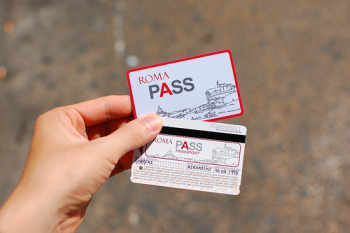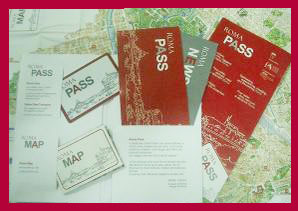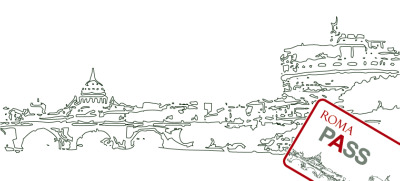Roma Pass: What it Covers & Whether it's Worth the Cost
 Pretty much every big city in the world that plays host to tourists sells some kind of “city pass.” These tend to include some combination of that city’s museums and attractions as well as use of public transportation. As you’d expect, Rome has one – and it’s called the Roma Pass.
Pretty much every big city in the world that plays host to tourists sells some kind of “city pass.” These tend to include some combination of that city’s museums and attractions as well as use of public transportation. As you’d expect, Rome has one – and it’s called the Roma Pass.
The cost of a Roma Pass went up €2 in early 2010, so a pass now costs €25. Some travelers might not think twice about purchasing a Roma Pass – but if you’re on a really tight budget you might wince a little at the €25 pricetag. So in this article I’m going to go over a few things – what the Roma Pass covers, how to use the Roma Pass, whether a Roma Pass is worth the cost, and how to get a Roma Pass.
What the Roma Pass Covers
A Roma Pass costs €25 and is good for three full days after the first use. With a Roma Pass, you get the following things:
- Free entry to first two museums and/or archaeological sites visited
- Discounted entry to all other included museums and/or archaeological sites after that
- Discounted entry to some exhibits & events
- Free public transportation in Rome (bus, metro, Met.Ro trains, trams)
- Discounted multi-lingual medical service for tourists via 24-hour call center (MET Travel Health)
Note that the Roma Pass does not cover transport Trenitalia (Italy’s national train system) or the Leonardo Express (train to/from Fiumicino Airport in Rome), and not everything in Rome is on the list of included attractions. Still, there are some interesting perks that come with a Roma Pass in addition to the obvious ones.
For one thing, the idea of having discounted access to a multi-lingual call center for medical assistance in an unfamiliar city is an interesting one. It’s certainly not like getting travel insurance, but if you haven’t bought insurance and you find yourself in a situation that requires more than just a band-aid, you might be really pleased you’d purchased a Roma Pass and the discounted medical assistance that comes with it.
Another perk that comes with the Roma Pass is the ability to bypass the line at the Colosseum – there’s a separate line and turnstile just for Roma Pass-holders. Low-season visitors may not understand why this is such an excellent perk, since the lines to get into the Colosseum aren’t as insane then, but peak-season travelers will really appreciate sauntering past the long line and flashing their Roma Pass card to get in.
Keep in mind that the three-day clock on the Roma Pass starts ticking when you first use the card to either get into one of the included museums/attractions or the first time you ride public transport. If you’ll be in Rome for longer than three days and don’t want to validate your Roma Pass until your second day in the city, you’ll just need to make sure you’re buying bus/metro tickets to get around until then.
A few of the things you get along with the Roma Pass itself are:
- A map of Rome that includes pointers for Tourist Information offices and metro stations (included attractions are also marked on the map, along with each attraction’s address, open hours, and nearby bus/metro stops)
- A guide to all participating museums and sites included in the Roma Pass
- More information on how to use the Roma Pass and how to take advantage of its other perks (medical help, online help)
Some of the 40+ included museums/sites on the Roma Pass are:
- Colosseum
- Roman Forum
- Palatine Hill
- Capitoline Museums
- Baths of Caracalla
- Borghese Gallery
- Castel Sant’Angelo
- Ara Pacis Museum
- National Museum in Rome
- Trajan’s Market & Forum
- National Museum of Musical Instruments
- Planetarium & Astronomy Museum
- Ostia Antica Excavation Site
How to Use the Roma Pass
 As mentioned, the Roma Pass is good for three consecutive days. It’s similar to a Eurail Pass in that you’ll fill out the appropriate section with your name and the validation date. This date should be the first day you plan to use the pass – which may or may not be the first day of your stay in Rome. If you’ll be in Rome for fewer than three days, then this isn’t a critical point – but if you’ll be in the city for more than three days and you’re not planning to use it immediately upon arrival, make sure you enter the date you’re going to start using the pass. And, as I said earlier, if you’re riding public transportation in Rome before the validation date of your Roma Pass, make sure you buy tickets for your trips.
As mentioned, the Roma Pass is good for three consecutive days. It’s similar to a Eurail Pass in that you’ll fill out the appropriate section with your name and the validation date. This date should be the first day you plan to use the pass – which may or may not be the first day of your stay in Rome. If you’ll be in Rome for fewer than three days, then this isn’t a critical point – but if you’ll be in the city for more than three days and you’re not planning to use it immediately upon arrival, make sure you enter the date you’re going to start using the pass. And, as I said earlier, if you’re riding public transportation in Rome before the validation date of your Roma Pass, make sure you buy tickets for your trips.
The first two museums/attractions you visit are the ones that count as your “two free sites” – so you definitely want to look at the ticket prices for all the museums and other attractions you’re planning to visit during your stay in Rome to make sure you’re using the pass to get into the two most expensive attractions. At the first two attractions, you won’t have to wait in a ticket line to get in – you can go straight to the entrance and show your Roma Pass.
At any other attractions you visit after those first two free ones, the Roma Pass will entitle you to a discounted ticket rate. You will have to wait in the ticket line to purchase tickets like everyone else, but when you show the ticket agent your Roma Pass you won’t have to pay full price. You may be asked to verify that the pass is yours, so make sure you’ve got your ID with you when you’re going to use the Roma Pass.
Is the Roma Pass worth the cost?
 Strictly financially speaking, it’s fairly easy to figure out whether you’d be getting your money’s worth if you bought a Roma Pass. All you need to do is add up the ticket prices of the various museums and attractions you planned on visiting while in Rome – the ones that are part of the Roma Pass, that is – and then compare that to the cost of the pass itself, plus the discounted entry fees for any sites you visit past the first two free ones. Assuming you were planning on riding buses, trams, or the metro now and again, you’ll want to factor in the savings of several transportation tickets as well.
Strictly financially speaking, it’s fairly easy to figure out whether you’d be getting your money’s worth if you bought a Roma Pass. All you need to do is add up the ticket prices of the various museums and attractions you planned on visiting while in Rome – the ones that are part of the Roma Pass, that is – and then compare that to the cost of the pass itself, plus the discounted entry fees for any sites you visit past the first two free ones. Assuming you were planning on riding buses, trams, or the metro now and again, you’ll want to factor in the savings of several transportation tickets as well.
This sounded very simple until I went looking for what, exactly, the discounted prices on all of those museums and attractions would be. Sure, discounts are always good things, but if you don’t know how much the discounted ticket price is then you can’t really figure out the true cost of the Roma Pass. This article on EuroCheapo attempted to lay out a mathematical comparison of buying a Roma Pass or buying individual tickets instead, but the author only talks about the two free attractions and doesn’t include anything about the discounted tickets.
Thankfully, after much digging on the Roma Pass website, I was able to find a PDF of exactly what I was looking for – a table comparing the current full-price of a ticket with the reduced rate you’d pay if you had a Roma Pass. The ticket prices that are on this PDF at the moment are 2010 prices.
Using this PDF, here are some examples of the cost difference between a full-price ticket (without a Roma Pass) and a discounted ticket (with a Roma Pass, after your first two free attractions):
| Museum/Attraction | Ticket w/o Roma Pass | Ticket w/Roma Pass |
| Capitoline Museums | €6.50 | €4.50 |
| Borghese Gallery | €8.50 | €5.25 |
| Castel Sant’Angelo Museum | €5 | €3 |
| Ostia Antica Site | €6.50 | €3.25 |
As you can see, the Roma Pass knocks a few euro of the price of every attraction – and in some cases the cost of entry is cut in half. Since it’s only the first two attractions that are completely free, you want to plan it so those are the first two you visit on your Roma Pass. And since entry to the Colosseum is now up to €12 as of this writing, that’s one of the sites you’ll want to visit first!
There’s an additional perk to visiting the Colosseum as one of your first two attractions on your Roma Pass, too. Because the Colosseum is on what’s called a “combined ticket” with the Roman Forum and the Palatine Hill, your free entry to the Colosseum also gets you free entry into those two sites – whether you’ve already used your other free entry or not. Of course, you can visit any of these three sites on the Colosseo/Palatino/Foro Romano “combined ticket” in any order you like, but you’ll save the most money if you at least make one of them your first two stops on your Roma Pass.
There are a few “combined tickets” that are included on the Roma Pass, and this information is also listed on that PDF that shows full-price vs. discounted-price tickets (it’s a handy one-page document). The other thing to note from that PDF is the phrase “prenotazione obbligatoria” underneath the listing for the Galleria Borghese – this means you’ll have to reserve a specific time to visit in advance, whether you have a Roma Pass or not. There’s a €2 fee for making the reservation, and that’s the same for everyone.
So, the bottom line is that to be completely certain the Roma Pass is a good deal for you, you’ll need to have a rough idea of the museums and other attractions from the Roma Pass list that you’d like to see – and you’ll need to do a little math. But at least now you have the tools you need to do all the figuring necessary!
Where to Buy a Roma Pass
You can buy a Roma Pass at any of the museums/attractions included on the pass, just tell them at the ticket window that you’d like to buy the pass and validate it right then. You can also buy a pass at any of the Tourist Information offices in Rome, and there’s also a way to buy it online. The Roma Passes cannot be mailed to you, however, so even if you buy it online in advance you’ll pick it up in Rome. In the purchase process you choose which Tourist Information office you’ll pick up your pass from.
You’ll find all the information you need to buy a Roma Pass on this page of the official site, including the locations and hours of all the TI offices in Rome. And here’s the main Roma Pass page.
photo at top by cobacco